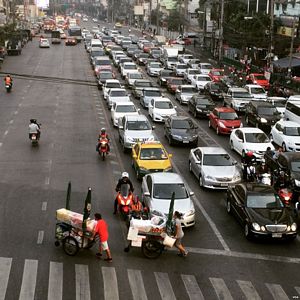|
By accessing or using The Crittenden Automotive Library™/CarsAndRacingStuff.com, you signify your agreement with the Terms of Use on our Legal Information page. Our Privacy Policy is also available there. |

If You’re Reading This in Jakarta, You’re Probably Stuck in Traffic
|
|---|
|
|
If You’re Reading This in Jakarta, You’re Probably Stuck in Traffic
Steve Herman, VOA News
4 February 2015 (1:07AM)
 Morning traffic in Bangkok, named as the world's eight worst city for road congestion, Jan. 22, 2015. (Steve Herman/VOA News) Morning traffic in Bangkok, named as the world's eight worst city for road congestion, Jan. 22, 2015. (Steve Herman/VOA News)
|
BANGKOK—Three of the ten worst cities in the world for traffic congestion are in Southeast Asia. Recently-compiled data reveals city drivers around the world are spending an average of one-third of their journey idling.
It is a common refrain among drivers in Asia’s big cities to lament they are stuck in the world’s most awful traffic.
However, unless one is in Jakarta, staring at the unmoving vehicle in front, it could be worse.
An analysis based on satellite navigation data, contributed by motorists in 78 cities around the world using TomTom GPS devices, puts the Indonesian capital just slightly ahead of Istanbul for total stop-and-starts. Mexico City, Surabaya, Indonesia and St. Petersburg, Russia are next in the long line.
Rounding out the top ten in the Magnatec Stop-Start Index (compiled by UK-based engine oil maker Castrol) are: Moscow, Rome, Bangkok, Guadalajara and Buenos Aires.
In China, Shanghai’s traffic congestion was found to be worse than Beijing’s. Drivers in Shanghai spend 33 percent of their time on the road idling, compared to little more than 27 percent for Beijing’s motorists.
In Jakarta, the country director of the Institute for Transportation and Development Policy, Yoga Adiwinarto, explained that during peak hours he experiences frustrating gridlock, and stop-and-start movement the rest of the day.
“Once you get out from your house, if you live sort of in the city center area, then you obviously meet with the congestion straight away,” said Adiwinarto.
In a metropolitan area of 24 million people, only 13 percent of trips are on public transport in Jakarta.
Investment in public transport in the Indonesian capital began in 2004. Construction is now underway on the initial phase of a subway system, known as the Mass Rapid Transit railway, in large part financed by Japan.
Adiwinarto says it is too little, too late.
“We had a late start in realizing that economic growth and, also, population growth needs to be taken care of. And we just realized that in the last few years,” said Adiwinarto.
To try to alleviate the congestion, the government has lifted a fuel subsidy and banned motorcycles from the capital’s main roads. Jakarta plans next year to institute electronic road pricing in two heavily congested corridors.
Adiwinarto at the Institute for Transportation and Development Policy predicts the daily automotive commute should then eventually get into a higher gear.
“That will move people from private cars and motorcycles to public transport in a few years,” he said.
Until then, Jakarta’s car commuters can only envy their counterparts in Tampere, Finland and Rotterdam in the Netherlands - the survey’s two cities with the fastest moving traffic.

















 Morning traffic in Bangkok, named as the world's eight worst city for road congestion, Jan. 22, 2015. (Steve Herman/VOA News)
Morning traffic in Bangkok, named as the world's eight worst city for road congestion, Jan. 22, 2015. (Steve Herman/VOA News)
